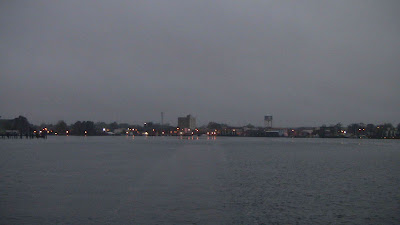Well, we sure aren't going anywere soon! The winds and rain continue to pound the east coast (I'm sure you got some of this in Roanoke, too!).
The rain has raised the tide to a level we haven't seen here. It is covering our dock (no, we aren't leaving the boat to walk in it). We moved the car from the water level parking lot to a higher point yesterday and walked back to the boat before the water got this high.
The wind gusts have reached almost 40 knots over night. The forecast is over 50 knots, maybe as high as 60 knots, later today and tonight.
We haven't lost electricity yet, as the water isn't over our electrical outlet yet --- that's out wire, the yellow line under water on the dock. The wire itself is waterproof. It's the outlet that we need to worry about.
Our outlet is actually up about 10 inches from the water level now BUT the forecast is for another 10 inches of tide during the high tide tonight. That will put the tide level at the same height as during Hurricane Isabel. We'll go out during the afternoon low tide and unplug the boat. That'll mean no electricity, but we don't want to ruin the wire.
So, we're safe and sound and boat bound. It's still supposed to be high water and wind tomorrow and Saturday. I guess we'll leave Sunday -- we'll have to check the ICW and see if the Dismal Swamp passage is open. This flooding will bring a lot of debris into the water.
Our visit to Judy's in Norfolk was fun. We had a great dinner, spent the evening and night with Judy, and then did some sightseeing before heading back to Deltaville on Tuesday. First was a visit to the Cape Henry Lights. The beautiful old one...
and the more functional newer one

There is a interesting twist to our Revolutinary War history at this point on the bay. In "The Battle of the Capes", the British fleet of about 19 ships, under Admiral Graves, came down the coast from New York to resupply and reinforce General Cornwallis at Yorktown. They surprised the French fleet under Admiral DeGrasse, with 24 ships, landing troops, and preparing to help General Washington attack Yorktown. Even though the French fleet was caught undermanned, and had to struggle to get out of the Chesapeake one ship at a time, rather than attacking, Admiral Graves waited 'till the French ships were all out of the bay, and both fleets could form the traditional "line of battle". The result was more or less a draw, leading to a few days of the fleets eying each other from a distance. On the fourth night of this, the French snuck back to the Chesapeake, denying Cornwallis much needed reinforcements, joining Washington in the attack, and forcing Cornwallis to surrender at Yorktown. That was a major blow to the British attempt to quell the colonists' rebellion. For more details than you probably want ---
Second Battle of the VA Capes
Next, a quick ride to the downtown Virginia Beach boardwalk.
Then we spent the afternoon at the Maritime Museum - could have spent a lot more time there! They have a great display on the Union ironclad Monitor and the Confederate version, the CSS Virginia (the captured Union sailing ship known as the Merrimack, radically converted into the Confederate ironclad CSS Virginia ).
The museum has the turret of the Monitor, recovered off Cape Hatteras in 2003. It's in a huge chemical bath, slowly being restored. You can't see anything but the tank, but here is one of her cannons, being restored in a similar chemical bath.
Interesting historical insight: Having few naval resources, the Confederacy eagerly embraced and successfully impemented new technologies, such as ironclads, and even submersibles, and caused great constenation in the Union navy. The Monitor was built in 100 days in response to the Confederate ironclad threat. Even though from pictures it looks like a little pill box floating on the water, it's actually about 140 ft long, and quite opulently finished below decks.
The wind seems to be picking up and we need to check things, so I'll quit for now. Then I can knit some more!






































